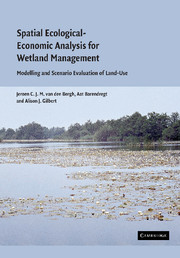 Spatial Ecological-Economic Analysis for Wetland Management
Spatial Ecological-Economic Analysis for Wetland Management Book contents
- Frontmatter
- Contents
- List of figures
- List of tables
- Preface
- 1 Introduction
- 2 Wetlands and science
- 3 Integrated modelling and assessment
- 4 Theoretical framework and method of integrated study
- 5 The Vecht area: history, problems and policy
- 6 Development scenarios for the Vecht area
- 7 The spatial–ecological model: hydrology and ecology
- 8 The spatial–economic model: agriculture, nature conservation and outdoor recreation
- 9 Performance indicators for the evaluation
- 10 Evaluation of the scenarios
- 11 Conclusions: policy and research implications
- References
- Index
6 - Development scenarios for the Vecht area
Published online by Cambridge University Press: 24 November 2009
- Frontmatter
- Contents
- List of figures
- List of tables
- Preface
- 1 Introduction
- 2 Wetlands and science
- 3 Integrated modelling and assessment
- 4 Theoretical framework and method of integrated study
- 5 The Vecht area: history, problems and policy
- 6 Development scenarios for the Vecht area
- 7 The spatial–ecological model: hydrology and ecology
- 8 The spatial–economic model: agriculture, nature conservation and outdoor recreation
- 9 Performance indicators for the evaluation
- 10 Evaluation of the scenarios
- 11 Conclusions: policy and research implications
- References
- Index
Summary
Introduction
This chapter presents development scenarios for the Vecht area that will be used in the integrated modelling exercise reported in later chapters. These scenarios reflect choices made in physical planning, nature policy, agricultural policy and the regulation of recreation and drinking water production, which are the main political and economic interests in the area. The scenarios have a spatial disaggregation and are formulated at polder level. The hydrological parameters are defined at grid level (500 m × 500 m) and the economic parameters at polder level. This is because the hydrological model assumes homogeneity and is formulated at grid level, while the economic model is formulated at the polder level. Any information at grid level can be aggregated up to polder level.
As the static model approach is used, static scenarios are formulated. Each scenario will provide information about land use and water levels at polder level for 72 polders (Fig. 6.1). The procedure for such a spatially disaggregated approach is complicated. Land use depends on the type of activity and the type of soil. The first includes historical conditions, classified into agricultural land (grassland, cropland), nature and forestry, urban settlements and open water. The soil type is classified into sand, clay and peat.
- Type
- Chapter
- Information
- Spatial Ecological-Economic Analysis for Wetland ManagementModelling and Scenario Evaluation of Land Use, pp. 106 - 115Publisher: Cambridge University PressPrint publication year: 2004


